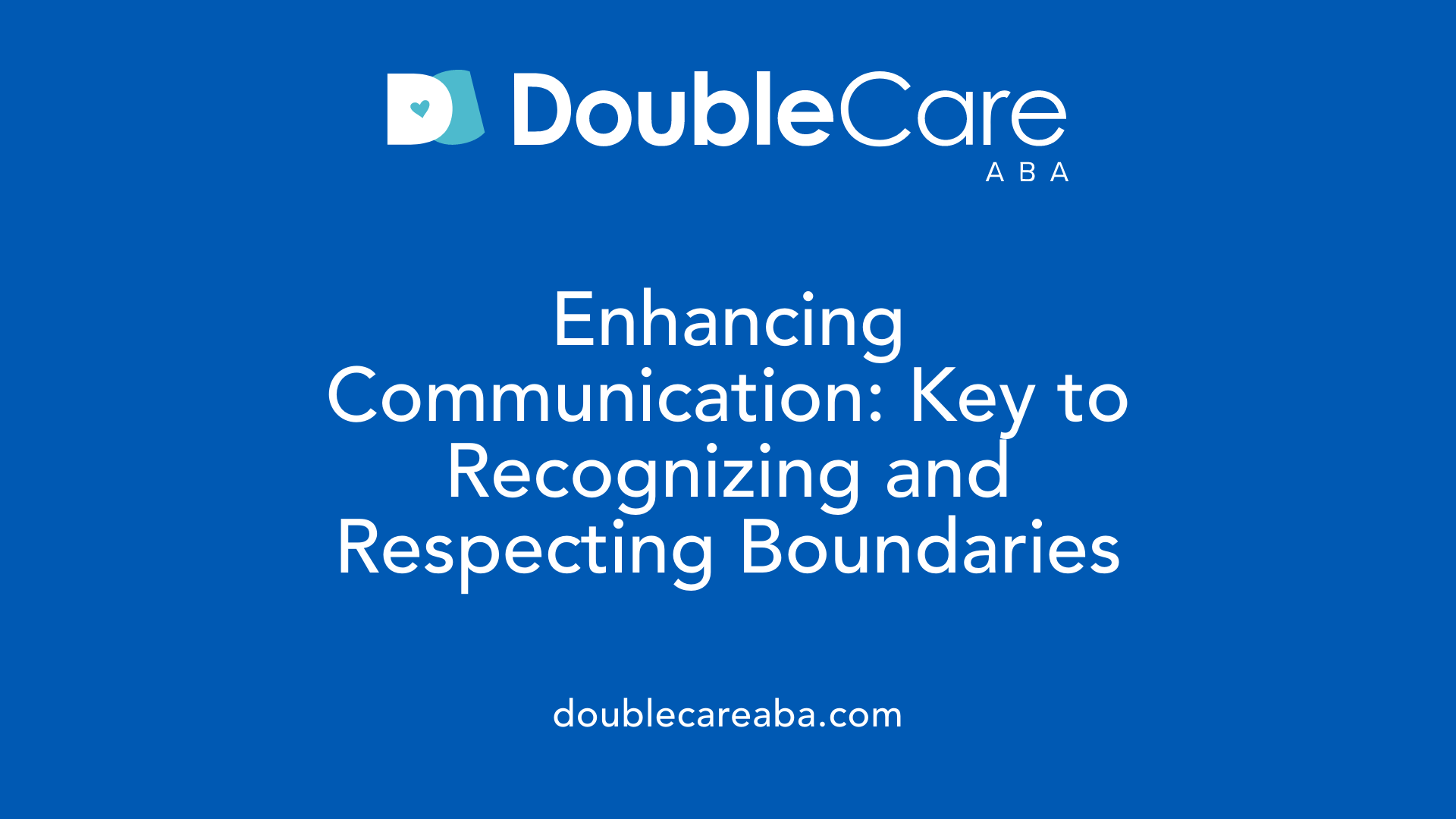Teaching Children with Autism to Identify Personal Boundaries
Empowering Autistic Children with Behavioral Strategies to Understand Personal Boundaries

Why Teaching Personal Boundaries is Crucial for Children with Autism
Understanding and respecting personal boundaries is a foundational social skill that supports safe and positive interactions. For children with autism spectrum disorder (ASD), recognizing and asserting these boundaries can be particularly challenging due to difficulties in social communication and behavior regulation. This article explores evidence-based behavioral interventions, particularly Applied Behavior Analysis (ABA) therapy, that equip autistic children with the skills needed to identify and respect personal boundaries—promoting their independence, social inclusion, and emotional well-being.
What is Applied Behavior Analysis (ABA) Therapy and How It Supports Boundary Recognition?

Definition and principles of ABA therapy
Applied Behavior Analysis (ABA) therapy is a scientifically supported method used to help children with autism develop essential skills while reducing challenging behaviors. It relies on the systematic observation of behaviors and applies principles like positive reinforcement to encourage desirable actions. ABA programs are tailored to each individual, targeting specific behaviors through structured learning.
ABA's role in skill development
ABA helps children learn critical skills including communication, social interaction, self-care, play, and academics. By breaking down complex tasks into smaller, manageable steps, techniques like Discrete Trial Training (DTT) support gradual mastery. This structured approach helps children build independence and confidence in various areas.
Use of ABA in teaching social and personal boundaries
One significant benefit of ABA is teaching children to recognize and respect social and personal boundaries. Therapists use modeling, prompting, and reinforcement to encourage appropriate behaviors such as personal space awareness and consent during interactions. This strengthens social skills and helps children navigate real-world situations safely and respectfully.
Techniques such as positive reinforcement and natural environment training
ABA employs positive reinforcement where desired behaviors are rewarded, increasing their frequency. Training often occurs in natural environments like home or school to ensure skills generalize beyond therapy sessions. This naturalistic approach helps children practice boundary recognition in everyday settings, making learning more meaningful.
Assessment and individualized program design
Therapists assess behaviors using models like Antecedent-Behavior-Consequence (ABC) to understand triggers and outcomes. This data guides the personalized design of therapy plans that focus on each child's unique needs, including boundary recognition skills. Progress is continuously monitored, allowing adjustments for optimal effectiveness.
Settings and customization
ABA therapy can be delivered at home, in clinics, schools, or community settings, adapting to the child's comfort and routine. High treatment intensity—typically about 25 hours per week for young children over at least two years—is recommended to achieve significant improvements.
Outcome evidence from research
Research spanning over 50 years supports ABA’s effectiveness. Studies show that up to 50% of children receiving comprehensive ABA programs exhibit remarkable gains, including enhanced communication, social understanding, and behavior regulation. These improvements lay the foundation for better boundary recognition and safer social interactions.
Qualified Professionals Delivering ABA Therapy for Personal Boundary Skills

Who Typically Provides ABA Therapy for Individuals with Autism?
ABA therapy is usually delivered by trained professionals such as Board Certified Behavior Analysts (BCBAs), behavior technicians, and licensed therapists specializing in behavioral analysis and autism support. These experts assess the individual's unique needs to create tailored treatment plans aimed at improving skills including personal boundaries.
Responsibilities of Providers in ABA Therapy
Providers are responsible for designing, implementing, and regularly updating intervention programs. They use data-driven techniques to teach personal boundaries, communication, and social skills while reducing challenging behaviors. Constant monitoring and adjustment ensure the therapy remains effective.
Therapy Settings: Home, School, Community
ABA therapy can be provided across multiple environments. In-home therapy offers personalized support within a familiar setting, fostering comfort and consistency. School-based programs enable collaboration with educators and opportunities for peer interaction. Community settings help generalize personal boundary skills in real-life social contexts.
Collaboration with Families and Caregivers
Close collaboration with families and caregivers is vital. They participate in training sessions and ongoing communication to reinforce personal boundary skills outside therapy hours. This team approach helps maintain progress and promotes consistency across environments.
Considerations in Choosing a Behavioral Therapist
When selecting a behavioral therapist, consider their credentials, experience, and approach. Providers should demonstrate compassion and adaptability to individual needs, ensuring therapy is personalized and supportive. Evaluating these factors can greatly influence successful outcomes in teaching personal boundary skills.
Behavioral Techniques for Teaching Personal Boundaries to Children with Autism

How is positive reinforcement and prompting used in teaching personal boundaries?
Positive reinforcement and prompting are foundational strategies in behavioral therapy for children with autism. Therapists reward desired behaviors related to respecting personal boundaries—such as waiting for permission before touching—thereby increasing the likelihood these behaviors will recur. Prompting helps guide children through appropriate social responses initially, providing cues or reminders which are gradually faded as the child learns independence.
What role does Discrete Trial Training (DTT) play?
DTT breaks down the learning of personal boundaries into manageable steps, each taught systematically with clear instructions, immediate responses, and rewards for correct behavior. For example, a trial may consist of teaching a child to say "Stop" when someone is too close, reinforcing the behavior immediately upon success. This approach offers a structured and measurable way to build crucial boundary skills.
How do naturalistic interventions like Pivotal Response Training (PRT) fit in?
PRT supports learning in natural settings by encouraging child-initiated interactions and using real-life motivators. When teaching personal boundaries, PRT may involve engaging the child’s interests and reinforcing respectful boundary behaviors during playful activities, promoting generalization in daily scenarios.
Why are modeling and role-playing used?
Modeling and role-playing simulate social situations where personal boundaries are relevant. Through watching adults or peers demonstrate appropriate responses and practicing these scenarios, children gain concrete examples and hands-on experience. This prepares them for real social encounters with increased confidence.
How are social scripts and peer interactions incorporated?
Practicing conversations that include social scripts—prearranged dialogue addressing personal space—helps children understand what to say in boundary-related situations. Social skills groups enable peer interactions where these scripts are applied, supporting pragmatic language use and social understanding.
How is gradual generalization to real-world settings achieved?
Generalization from therapy to everyday environments requires gradual exposure and consistency. Therapists and caregivers collaborate to reinforce boundary skills across home, school, and community settings, allowing children to practice and maintain skills amidst varied social contexts.
| Technique | Description | Benefit |
|---|---|---|
| Positive reinforcement & prompting | Rewarding desired boundary-respecting behavior and offering guided cues | Encourages repetition and independence |
| Discrete Trial Training (DTT) | Teaching boundary skills in structured, stepwise trials | Clear, measurable skill acquisition |
| Pivotal Response Training (PRT) | Child-led playful sessions applying social rules | Promotes natural generalization |
| Modeling & role-playing | Demonstrations and practice of social situations | Builds social confidence and understanding |
| Social scripts & peer interactions | Using scripted dialogues and group practice | Enhances pragmatic language and social skills |
| Generalization planning | Reinforcing skills in multiple real-world contexts | Maintains and expands learned behaviors |
Addressing Communication Challenges to Support Boundary Recognition

What is Verbal Behavior Therapy within ABA?
Verbal Behavior Therapy (VBT) is a specialized form of Applied Behavior Analysis (ABA) that focuses on teaching communication skills to children with autism, especially those who are non-vocal. VBT uses modeling and reinforcement strategies to encourage children to communicate purposefully and functionally.
How is functional communication taught to non-vocal children?
Therapists use natural environments to model language and motivate children to use words or alternative communication methods to express needs and emotions. This might involve:
- Modeling single words or phrases
- Reinforcing attempts to communicate
- Breaking communication down into manageable steps
How does this therapy encourage purposeful use of words for expressing limits?
By systematically reinforcing the use of words or gestures to indicate wants or boundaries, children learn to articulate their limits clearly. For example, a child may be taught words or signs that mean "stop" or "no," which express personal boundaries effectively.
What is the role of assistive communication tools?
Assistive communication tools such as speech-generating devices and picture exchange systems support children who struggle with verbal speech. These tools facilitate consistent, intentional communication, enabling children to assert their needs and boundaries in everyday interactions.
How does improved communication support social boundaries and self-advocacy?
Effective communication empowers children to establish and respect social boundaries while reducing problematic behaviors linked to frustration and misunderstanding. By learning to communicate their feelings and choices, children develop self-advocacy skills essential for social interaction and personal safety.
Emotional Regulation and Coping Skills in Establishing Personal Boundaries
What is the Role of Cognitive Behavioral Therapy (CBT) in Autism?
Cognitive-behavioral therapy (CBT) is an effective approach for children with autism who have less severe impairments. It focuses on reducing anxiety and addressing challenging behaviors that often arise in social settings. By targeting thought patterns, CBT helps children understand and manage their emotions more effectively.
How Does CBT Teach Emotion Regulation and Impulse Control?
CBT teaches children to recognize their emotional triggers and develop coping strategies to manage impulses and reactions. Techniques may include identifying feelings, practicing relaxation, and applying problem-solving skills. This structured approach builds self-awareness, allowing children to control behaviors that interfere with safe and respectful interactions.
In What Ways Does CBT Reduce Anxiety Related to Social Interactions?
Social situations can be stressful for autistic children, often leading to anxiety. CBT provides tools to anticipate and cope with these situations by using role-play, social stories, and gradual exposure. It empowers children to approach social settings with confidence, reducing fear and avoidance.
How Does Therapy Help Children Express Feelings of Discomfort or Upset?
Learning to communicate feelings of discomfort or upset is crucial in establishing personal boundaries. CBT encourages functional communication by helping children identify emotions and express them clearly, often through verbal methods or alternative communication strategies. This expression avoids escalation and supports assertive boundary-setting.
What Support is Available for Managing Challenging Behaviors Around Boundaries?
Challenging behaviors such as frustration or aggression can arise when boundaries are tested. Behavioral therapies, including ABA, often work alongside CBT to provide consistent reinforcement for positive behaviors. Support includes teaching alternative responses, offering calming techniques, and involving caregivers in training to maintain a cohesive approach.
Overall, CBT plays a central role in helping children with autism develop emotional regulation and coping skills crucial to respecting and establishing personal boundaries. These therapeutic strategies enable improved social engagement, emotional well-being, and safer interactions.
Social Skills Groups and Peer Interaction to Reinforce Boundary Learning
How do social skills groups help with pragmatic language development?
Social skills groups provide structured settings where children with autism can practice pragmatic language—using language appropriately in social contexts. These groups focus on enhancing communication skills that are essential for successful peer interaction.
How are real-life social situations mimicked in therapy?
Through role-playing and simulated social scenarios, therapists recreate situations children are likely to encounter daily. This hands-on practice helps children learn social norms, like personal boundaries, in a controlled and supportive environment.
What role do peer-mediated interventions play?
Peer-mediated interventions involve typical peers acting as social partners or models, encouraging natural interaction. This approach fosters genuine social engagement and helps autistic children interpret social cues and respond appropriately.
How are social scripts used to practice boundaries?
Social scripts provide scripted phrases or cues that guide children on what to say or do in specific situations, such as asking for personal space or responding when boundaries are crossed. Practicing these scripts helps children gain confidence and understanding about social limits.
What challenges exist in generalizing these skills to everyday life?
Despite progress in social skills groups, transferring learned behaviors to unstructured, real-world environments can be slow. Children may require patience and consistent reinforcement as they adapt skills beyond the therapy setting.
By combining these elements, social skills groups effectively nurture children's ability to recognize and respect personal boundaries, promoting healthier peer relationships and social development.
Integrating Family and Caregiver Involvement for Consistent Boundary Education
Parent Training Programs in ABA
Parent training programs are crucial components of ABA therapy, equipping caregivers with practical strategies to support their child's learning journey. These programs enable parents to apply behavioral techniques at home, reinforcing skills such as communication and self-care. By empowering families, the therapy becomes a continuous process beyond clinical settings.
Counseling and Support for Families
Families of children with autism often face emotional and practical challenges. Counseling services provide emotional support and guidance to help caregivers manage stress and develop coping strategies. Support groups and family counseling also foster a sense of community and collaboration, reducing feelings of isolation.
Creating Cohesive Therapy Environments
A consistent and cohesive approach between home and therapy settings is vital for teaching personal boundaries effectively. Coordination between behavioral therapists and families ensures that behavioral goals are consistently practiced and reinforced. Collaborative planning helps adapt interventions based on the child's progress and family dynamics.
Strategies for Caregivers to Reinforce Boundaries at Home
Caregivers play an essential role in reinforcing boundaries by using positive reinforcement and clear communication. Techniques include modeling appropriate interactions, establishing predictable routines, and gently correcting boundary-crossing behaviors. Consistency at home helps generalize these skills into natural environments.
Collaborative Approach Between Therapists and Families
Regular communication between therapists and families fosters shared understanding and alignment of therapeutic goals. Progress assessments and individualized plans are routinely reviewed to ensure effectiveness. This partnership builds trust and promotes a supportive atmosphere conducive to the child's development.
In summary, integrating family involvement through education, support, and collaboration enhances the effectiveness of behavioral therapy. It ensures that personal boundaries are taught and reinforced consistently, creating a nurturing and structured environment that promotes positive outcomes for children with autism.
Importance of Early and Intensive Intervention in Teaching Boundaries
What Evidence Supports Early Intensive Behavioral Intervention?
Early intensive behavioral intervention (EIBI) is one of the most validated approaches for children with autism spectrum disorder (ASD), backed by over 50 years of research. Studies have shown that children receiving EIBI demonstrate significant improvements in social engagement, communication skills, and reduction of problematic behaviors. Notably, up to 50% of children in comprehensive programs show remarkable progress when essential components are included.
How Does It Impact Brain Development and Neural Pathways?
Behavioral therapies like EIBI influence brain development by potentially rewiring neural circuits associated with social interaction and communication. By consistently reinforcing positive behaviors and functional communication, early intervention supports the development of critical pathways that may otherwise develop atypically in children with autism.
What Are the Recommended Intensity and Duration of Therapy?
Effective EIBI programs typically involve about 25 hours of therapy per week for a minimum of two years, especially when initiated between the ages of 2 and 4. This intensive schedule, coupled with trained staff, naturalistic environments, and active parent involvement, maximizes skill acquisition and behavioral improvements.
What Are the Long-Term Benefits for Social and Communication Skills?
Children participating in early intensive behavioral therapies show long-lasting gains in social and communication domains. These include enhanced ability to understand personal boundaries, improved pragmatic language skills, and better emotion regulation. Such skills facilitate smoother peer interactions and reduce challenging behaviors.
How Does Early Intervention Prepare Children for School and Community Inclusion?
By fostering essential life and social skills early on, EIBI sets the foundation for successful integration into educational settings and community activities. When paired with Individualized Education Programs (IEPs) and support groups, these interventions encourage children to participate more fully, improving academic outcomes and social inclusion prospects.
Monitoring Progress and Tailoring Interventions to Each Child's Needs

Regular assessment and data collection
Behavioral therapies for children with autism rely heavily on systematic observation and data collection. Therapists continuously record specific behaviors and skills targeted in therapy to assess how well the intervention is working. This ongoing monitoring helps identify which techniques are effective and which may need adjustment.
Use of measurable goals
Setting clear, measurable goals is essential in behavioral therapy. Goals might include increasing communication attempts, reducing challenging behaviors, or improving social interaction skills. Measurable targets allow therapists and families to track progress objectively and celebrate achievements, fostering motivation and engagement.
Adjusting therapy plans based on progress
Therapy plans are dynamic and regularly reviewed. When data shows steady progress, goals can be advanced or expanded. Conversely, if a child struggles with certain tasks, approaches are modified to better suit their learning style or developmental level. This flexibility ensures interventions remain personalized and effective over time.
Role of Individualized Education Programs (IEPs)
IEPs play a critical role in supporting children with autism within educational settings. Developed collaboratively by educators, therapists, and families, IEPs outline specific objectives and accommodations tailored to the child's unique needs. These plans help bridge therapy and classroom learning, promoting consistent development across environments.
Ensuring therapy remains effective and relevant
Regular assessments, combined with progress reports and team meetings, ensure that behavioral therapy adapts as the child grows. Therapists may incorporate new strategies or technologies to keep therapy engaging and aligned with current developmental goals. This ongoing adaptation maximizes the child's potential and supports long-term success.
Building a Foundation for Safe and Successful Social Interactions
Teaching children with autism to identify and respect personal boundaries requires a structured, individualized, and compassionate approach grounded in behavioral science. Applied Behavior Analysis (ABA) therapy, delivered by qualified professionals and supported by families, provides effective strategies to develop communication, emotional regulation, and social skills essential for boundary recognition. Early and intensive interventions, combined with consistent monitoring and adaptable goals, empower children to navigate social environments confidently while fostering respect for their own and others’ personal space. Ultimately, nurturing these skills enhances their independence, safety, and quality of life, paving the way for meaningful inclusion in all aspects of society.
References
- Understanding Behavioral Therapy for Autism
- Behavioral Therapies: Key Interventions in ASD
- How to Choose the Right Behavioral Therapist for Your ...
- Educational Interventions for Children and Youth with Autism
- Applied Behavior Analysis (ABA)
- 6 Benefits of ABA Therapy for Children with Autism
- Applied Behavior Analysis (ABA)
- The Future of Autism and ABA: Predicting Outcomes
- Applied Behavior Analysis (ABA)
















